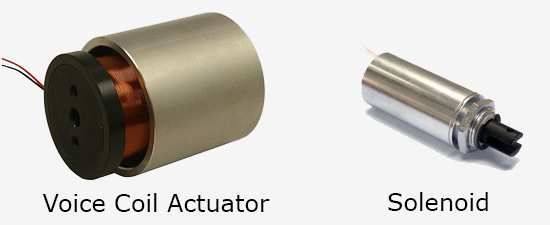What are the differences between solenoids and voice coil motors?

Projects involving linear motion have been challenging engineers for far too long when it comes to deciding between Solenoids and Voice Coil Actuators (VCAs).Both of these devices are electromechanical units capable of accomplishing similar tasks. However, there are several major differences between the two devices which makes it crucial to select the correct device suited for the project at hand. Engineers and consumers must compare the design capabilities of each component to determine which one of these two devices are more appropriate for their given application.

Solenoids:
The design of a solenoid consists of a coil with no magnet attached to the housing, a steel or an iron core, and usually a spring. The on/off components are controlled by simple switches. When current flows through the coil, the electromagnetic field created by the coil attracts the iron core. When coil is de-energized, the spring pushes the iron core back to its original position.
Sometimes engineers design solenoids without springs to move a common iron core back and forth. Solenoids can be designed to achieve a certain speed and amount of force. These settings are permanent once the movement speed and force is determined for the given solenoid.
Compared to Voice Coil Actuators, solenoids are able to meet linear motion requirements at a lower cost with a simple on/off control mechanism. Automobile starters and vending machines are among applications where solenoids are used to achieve simple tasks. If the application requires more than simple on-off control with precise positioning, then VCAs should be considered.
Voice Coil Actuators:
Voice Coil Actuators are designed in variety of shapes and sizes. There are two types of Voice Coil Actuators, moving coil VCAs and moving magnet VCAs. The moving coil VCAs consist of stationary field assembly and the moving coil assembly. Moving magnet VCAs have the coil attached to a stationary magnetically permeable housing which also serves as a conductor of the magnetic flux. The field assembly typically consists of an axially magnetized, permanent cylindrical magnet and two soft magnetic pole pieces attached to both ends of the magnet.
VCAs’ moving part, magnet or coil will travel in a given direction when voltage has been applied to its terminals. The direction of the moving magnet, or coil will change when polarity of the applied voltage is reversed.
Voice Coil Actuators are a must when precise control is necessary since they are available with position feedback devices. Additionally, VCAs can create more force than solenoids for a specific size, stroke, and input power because moving magnet VCAs consist of a stationary coil and a moving permanent magnet assembly, as opposed to a coil assembly and a piece of steel in a solenoid.
The Voice coil Motors have physical characteristics which makes them a preferred choice in medical, aerospace and military applications in which size and weight are as important as its functionality. A voice Coil Motor can weigh as little as 6 grams.
Specific requirements by an application will be the determining factor between which device to employ between VCAs and solenoids. Applications requiring short stroke or excursion angle use Voice Coil Actuators due to their high-power density components. If the application requires controlling force, speed, travel, acceleration/deceleration for continuous performance and accurate positioning, Voice Coil Motors are the clear choice.
- 26th September 2014